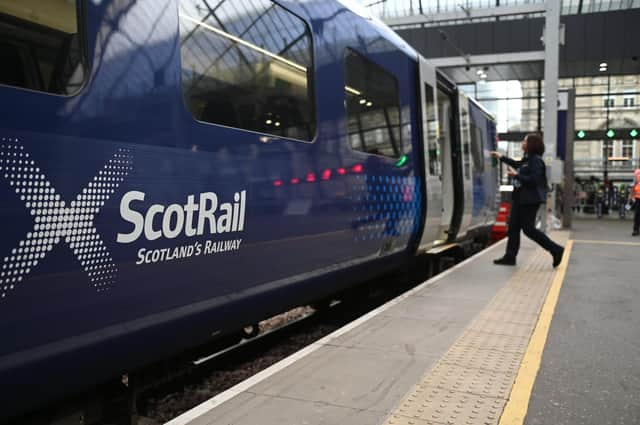ScotRail's move to public ownership must not delay work to improve the network – David Clarke


In particular, she set out her aims to create “an affordable, sustainable, customer-focused rail passenger service in Scotland in a post-pandemic world”.
If Scotland’s railways are to be successful, whatever happens when ScotRail transfers into the new structure, it is absolutely vital that rail supply businesses continue to be engaged throughout the process, and that they are able to maintain momentum in delivering improvements across the network.
Advertisement
Hide AdAdvertisement
Hide AdAcross Scotland, businesses of all shapes and sizes are playing their part in supporting and upgrading the railway. Companies across the network, both big and small, work tirelessly to keep the current infrastructure and rolling stock in good working order, whilst also working to expand, decarbonise and enhance the railways.
Whether it’s working at night to upgrade track and bridges, providing state-of-the-art video monitoring to solve issues before they occur, or erecting masts to electrify rail lines, the rail supply industry is delivering for Scotland.
Indeed, during extreme weather events like Storms Dudley and Eunice last week, many supply chain companies worked alongside their colleagues at Network Rail Scotland to repair damage to key lines and ensure services can run safely.
The industry is not just important in supporting the transport network, it is also a key economic driver, generating over £3 billion in economic growth and supporting 56,000 jobs in the country, according to a recent report from the Railway Industry Association on the value of rail to the UK. These skilled jobs, apprenticeships and investment reach almost all corners of the country.
A clear example of the whole industry working together to deliver new services and economic benefit can be found in the work currently underway to reopen the Levenmouth branch.
The new line will serve the largest urban area in Scotland without a rail link, and is being delivered by a collaboration between Network Rail and suppliers. It will see two new stations at Leven and Cameron Bridge and the whole line reopened and electrified so that it can play its part in transport decarbonisation.
Our railway industry is already doing much to deliver the “efficient, productive and sustainable” railway that Ms Gilruth set out last week, particularly to decarbonise the network.
In her statement, she also stressed the need to be “customer-focused”. All this is positive to hear, especially for an industry that can provide a convenient, green form of mass transit, helping to reduce carbon emissions.
Advertisement
Hide AdAdvertisement
Hide AdThese ambitions are underpinned by the Scottish government’s net-zero plan, announced by Cabinet Secretary Michael Matheson in 2020, which set an ambitious target to reach net-zero carbon emissions from transport by 2035.
This will include electrifying key railway lines, in particular major passenger and freight lines, such as routes from the Central Belt to both Aberdeen and Inverness and from Glasgow down to Cumbria.
It will also involve rolling out battery and hydrogen-powered trains on other lines, ensuring clean, reliable journeys for millions more passenger journeys. Several of these battery and hydrogen trains were on display at the United Nations’ COP26 climate summit in Glasgow last November, showing the industry has the capability and expertise to deliver them.
The industry is equally ambitious, and indeed optimistic that it can deliver the plan. One key part of this – the rolling programme of electrification – is already in place, providing visibility and, crucially, certainty about upcoming projects.
This gives companies the confidence to invest in skilling up workforces and new capabilities, such as complex machinery, which is necessary to build these projects. Whether electrification, signalling, rolling stock or other upgrades, the more visibility the rail supply chain can have, the more effectively and cost efficiently it can deliver. This openness and engagement must remain a key feature of the new structure for ScotRail.
Such an approach would also feed the appetite of the hundreds of businesses looking to expand into the railway industry – for example, through Scottish Engineering’s rail cluster builder initiative. The cluster will link small and medium-sized companies in Scotland with rail businesses of all kinds to bring innovative and new ideas to the railways.
However, as Scotland’s railways transition to a new model of ownership, what is vital is that there must not be any hiatus in existing work to progress this pipeline. As ScotRail undergoes changes, there is a risk that decisions to approve rail projects, whether upgrading or renewing parts of the network, are put on hold. This needs to be avoided.
Delaying decisions and any uncertainty over the status of projects will simply harm the industry’s current confidence to invest and build the necessary capabilities to continue upgrading the railways for Scottish passengers. Apprenticeship schemes, investment in new factories and machinery, and the upskilling of workers might all be halted if suppliers face uncertainty about the work coming down the line.
Advertisement
Hide AdAdvertisement
Hide AdMany of the businesses are of course based in Scotland, but hundreds of businesses right across the UK are also vital cogs in Scotland’s railway. All of them need certainty going forward.
So, as the Scottish government delivers these structural changes, it is important it continues to give the supply chain a seat at the table, which will continue to play pivotal role in building, maintaining and upgrading the country’s rail network now and in the future. The Railway Industry Association and our members look forward to being part of this journey.
David Clarke is the Railway Industry Association’s technical director and its Scotland lead
A message from the Editor:
Thank you for reading this article. We're more reliant on your support than ever as the shift in consumer habits brought about by coronavirus impacts our advertisers.
If you haven't already, please consider supporting our trusted, fact-checked journalism by taking out a digital subscription.
Comments
Want to join the conversation? Please or to comment on this article.
